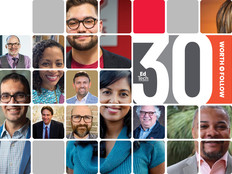To Elevate Campus Services, Take a Cue from Consumer-Facing Innovations
In a story in The Atlantic, “The Future of College Looks Like the Future of Retail,” Jeffrey Selingo points to a surprising twist in online education: Some programs are augmenting computer-based curricula with in-person services, giving online learners the same supports that make face-to-face learning attractive.
The online-degree company 2U, for example, partnered with coworking space WeWork to give students a place to meet up for classwork and collaboration. This move toward omnichannel service delivery is most familiar, of course, from the world of retail, Selingo writes: Eyeglasses retailer Warby Parker depends primarily on online commerce, but also engages customers through a select number of brick-and-mortar shops.
Evolving curricula-delivery modes is one example of consumer experiences shaping students’ expectations of college, but that’s not the only connection between two seemingly unrelated fields. Colleges face some of the same challenges (and opportunities) as retailers. And, increasingly, major retailers such as Target and Publix are opening small-footprint stores right on college campuses — apparently with great success.
In Some Respects, Colleges and Retailers Face a Similar Landscape
Today’s students have been heavily influenced by the technology-driven services delivered by retail and consumer companies, and it’s pushing them to expect a similar level of convenience from their colleges. That’s not entirely a bad thing. After all, IT staffers in higher education face similar challenges, such as surges on the network during registration periods that resemble the holiday uptick in online shopping. Most colleges offer consumer-oriented services, including stores, gyms, dining and entertainment.
And, as Michael Horn writes in a recent Forbes article, “Colleges and Retailers Share a Bloated Past and a Slimmed Down Future,” costly new building construction in higher education is putting institutions at financial risk, particularly in light of declining enrollment and increased competition.
A seamless blend of online and traditional instruction — informed by student choice, defined by convenience — is highly desirable to today’s learners. Studies show that as much as individual learners may gravitate toward traditional or online programs, as a group, they prefer a combination of the two modes.
A willingness to deliver that flexibility is a smart move for institutions. As colleges take a hard look at what it will take to remain financially sustainable in coming years, the more eggs in the basket, the better.
Finally, while colleges’ teaching assets — that is, the faculty, space and tools required to deliver instruction — are vastly different from a retailer’s product inventory, both benefit from solutions that help them predict and manage demand. Colleges that can better anticipate how many students will sign up for certain courses, for example, can shift resources accordingly, without having to turn away students (i.e., paying customers).
Students, Like Consumers, Want User-Friendly Service
Just as successful retailers strive to make every part of the customer journey easy to navigate and user-friendly, colleges should do the same. Many institutions have already launched initiatives to review student services campuswide, with the goal of replacing cumbersome systems with agile, technology-enhanced processes.
The core mission of higher education remains the same in many ways, but how leaders accomplish that mission is undergoing great change. What has not changed is that students still care deeply about the campus experience, especially when it’s the place they live, work, study and play.
“The quality of life inside and out of the classroom, combined with campus amenities and sustainable design, are deemed not just perks but priorities,” according a blog post from California-based architecture and planning firm SGPA.
For all these reasons, it makes sense to keep an eye on the retail sector for ideas and inspiration that can help colleges offer the streamlined, personalized service that today’s students expect.
This article is part of EdTech: Focus on Higher Education’s UniversITy blog series.










